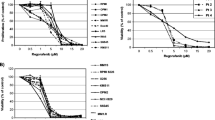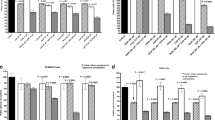Abstract
Bisphosphonates (BPs) are effective in the management of bone disease in patients with multiple myeloma. Recent reports have suggested that they may also have an antitumor activity. YM529 is a new synthetic BP with more than 1000 times the bone resorption inhibitory activity of pamidronate. To clarify the direct effects of YM529 on myeloma cells, the cell proliferation and cell cycle perturbation were analyzed using 12 myeloma cell lines established in our laboratory. The growth inhibition was dose dependent. The cells accumulated in [2n≪4n] of the cell cycle and subsequently formed an apoptotic sub-G1 fraction. Combined treatment with all-trans retinoic acid, thalidomide, or interferon-α enhanced the growth inhibitory effects of YM529 on these cells. However, there were no remarkable effects of YM529 on the messenger RNA expression for angiogenic factors, cell cycle regulators, or cytokines related to myeloma cells. These results indicate that YM529 is beneficial not only to bone lesions but also for its direct antitumor effects on myeloma cells.
Similar content being viewed by others
References
Callander NS,Roodman GD. Myeloma bone disease.Semin Hematol. 2001;38:276–285.
Rodan GA, Fleisch HA. Bisphosphonates: mechanisms of action.J Clin Invest. 1996;97:2692–2696.
Shipman CM, Croucher PI, Russell RG, Helfrich MH, Rogers MJ. The bisphosphonate incadronate (YM175) causes apoptosis of human myeloma cells in vitro by inhibiting the mevalonate pathway.Cancer Res. 1998;58:5294–5297.
Dhodapkar MV, Singh J, Mehta J, et al. Anti-myeloma activity of pamidronate in vivo.Br J Haematol. 1998;103:530–532.
Berenson JR, Lichtenstein A, Porter L, et al. Long-term pamidronate treatment of advanced multiple myeloma patients reduces skeletal events. Myeloma Aredia Study Group.J Clin Oncol. 1998; 16:593–602.
Shipman CM, Rogers MJ, Apperley JF, Russell RG, Croucher PI. Bisphosphonates induce apoptosis in human myeloma cell lines: a novel anti-tumour activity.Br J Haematol. 1997;98:665–672.
Aparicio A, Gardner A, Tu Y, Savage A, Berenson J, Lichtenstein A. In vitro cytoreductive effects on multiple myeloma cells induced by bisphosphonates.Leukemia 1998;12:220–229.
Derenne S, Amiot M, Barille S, et al. Zoledronate is a potent inhibitor of myeloma cell growth and secretion of IL-6 and MMP-1 by the tumoral environment.J Bone Miner Res. 1999;14:2048–2056.
Kunzmann V, Bauer E, Feurle J,Weissinger F,Tony HP,Wilhelm M. Stimulation of gammadelta T cells by aminobisphosphonates and induction of antiplasma cell activity in multiple myeloma.Blood.2000;86:384–392.
Usui T, Kawakami R, Watanabe T, Higuchi S. Sensitive determination of a novel bisphosphonate, YM529, in plasma, urine and bone by high-performance liquid chromatography with fluorescence detection.J Chromatogr. 1994;652:67–72.
Sasaki A, Kitamura K, Alcalde RE, et al. Effect of a newly developed bisphosphonate, YH529, on osteolytic bone metastases in nude mice.Int J Cancer. 1998;77:279–285.
Takahashi R, Shimazaki C, Inaba T, et al. A newly developed bisphosphonate, YM529, is a potent apoptosis inducer of human myeloma cells.Leuk Res. 2001;25:77–83.
Tassone P, Forciniti S, Gallea E, et al. Growth inhibition and synergistic induction of apoptosis by zoledronate and dexamethasone in human myeloma cell lines.Leukemia. 2000;14:841–844.
Jagdev SP, Coleman RE, Shipman CM, Rostami-H A, Croucher PI. The bisphosphonate, zoledronic acid, induces apoptosis of breast cancer cells: evidence for synergy with paclitaxel.Br J Cancer.2001;84:1126–1134.
Musto P, Sajeva MR, Sanpaolo G, DArena G, Scalzulli PR, Carotenuto M. All-trans retinoic acid in combination with alpha-interferon and dexamethasone for advanced multiple myeloma.Haematologica. 1997;82:354–356.
Singhal S, Mehta J, Desikan R, et al. Antitumor activity of thalidomide in refractory multiple myeloma.N Engl J Med. 1999;341:1565–1571.
Myeloma Trialists’ Collaborative Group. Interferon as therapy for multiple myeloma: an individual patient data overview of 24 randomized trials and 4012 patients.Br J Haematol. 2001;113: 1020–1034.
Otsuki T, Yamada O, Yata K, et al. Genetic and biological characterization of human myeloma cell lines: an overview of the lines established at Kawasaki Medical School.Gene Funct Dis. 2000;1:48–56.
Otsuki T, Yamada O, Sakaguchi H,et al. Human myeloma cell apoptosis induced by interferon-α.Br J Haematol. 1998;103:518–529.
Otsuki T, Yata K, Sakaguchi H, et al. IL-10 abolishes the growth inhibitory effects of all trans retinoic acid (ATRA) on human myeloma cells.Br J Haematol. 2002;116:787–795.
Hideshima T, Chauhan D, Shima Y, et al. Thalidomide and its analogs overcome drug resistance of human multiple myeloma cells to conventional therapy.Blood. 2000;96:2943–2950.
Berger LC, Hawley RG. Interferon-beta interrupts interleukin-6-dependent signaling events in myeloma cells.Blood. 1997;89: 261–271.
Tanaka K, Otsuki T, Sonoo H, et al. Semi-quantitative comparison of the differentiation markers and sodium iodide symporter in papillary thyroid carcinomas using RT-PCR method.Eur J Endocrinol. 2000;142:340–346.
Sato M, Grasser W, Endo N, et al. Bisphosphonate action. Alendronate localization in rat bone and effects on osteoclast ultra-structure.J Clin Invest. 1991;88:2095–2105.
Hideshima T, Chauhan D, Shima Y, et al. Thalidomide and its analogs overcome drug resistance of human multiple myeloma cells to conventional therapy.Blood. 2000;96:2943–2950.
Chen YH, Lavelle D, DeSimone J, Uddin S, Platanias LC, Hankewych M. Growth inhibition of a human myeloma cell line by all-trans retinoic acid is not mediated through downregulation of interleukin-6 receptors but through upregulation of p21 (WAF1).Blood. 1999;94:251–259.
Dallas SL, Garrett IR, Oyajobi BO, et al. Ibandronate reduces osteolytic lesions but not tumor burden in a murine model of myeloma bone disease.Blood. 1999;93:1697–1706.
Shipman CM, Vanderkerken K, Rogers MJ, et al. The potent bisphosphonate ibandronate does not induce myeloma cell apoptosis in a murine model of established multiple myeloma.Br J Haematol. 2000;111:283–286.
Author information
Authors and Affiliations
Corresponding author
About this article
Cite this article
Yata, K., Otsuki, T., Yamada, O. et al. Synergistic Growth Inhibition of YM529 with Biologic Response Modifiers (BRMs) in Myeloma Cells. Int J Hematol 75, 534–539 (2002). https://doi.org/10.1007/BF02982119
Received:
Revised:
Accepted:
Published:
Issue Date:
DOI: https://doi.org/10.1007/BF02982119




